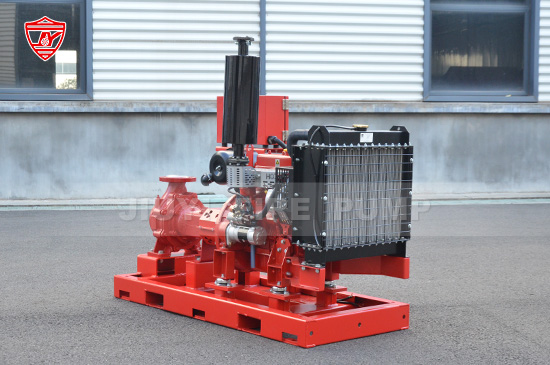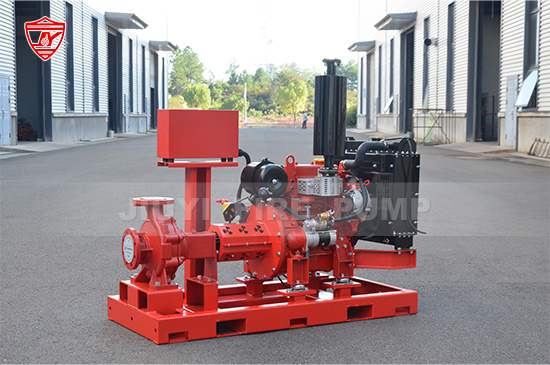Diesel fire pumps play a vital role in emergency fire protection systems, ensuring water is delivered at the required pressure and flow rate when needed most. However, one of the most common and potentially damaging issues in diesel fire pump systems is overheating. When a diesel fire pump overheats, it can lead to engine failure, reduced performance, and even system shutdown during critical fire-fighting operations.
This article explains the causes of overheating, the impact it has on system reliability, and effective methods to prevent it—ensuring your fire protection system remains fully functional and compliant with NFPA 20 standards.

Overheating in diesel fire pumps is primarily a result of inefficient cooling or excessive engine load. Unlike electric fire pumps, diesel-driven systems generate substantial heat during operation, which must be properly managed to maintain safe temperature levels.
Common causes include:
Cooling system failure – Malfunctioning radiators, blocked coolant passages, or inadequate airflow can quickly lead to overheating.
Low coolant levels – Leaks or improper maintenance can cause a shortage of coolant, reducing heat dissipation.
High ambient temperature – In enclosed pump rooms or outdoor installations in hot climates, environmental heat can raise operating temperatures.
Overloading – If the fire pump operates beyond its designed pressure or flow, the engine is forced to work harder and generates more heat.
Dirty or clogged filters – Dust and debris can block air or fuel filters, reducing cooling efficiency and combustion quality.
Poor ventilation – Without sufficient air exchange, the heat accumulates in the pump room, exacerbating the issue.
Identifying the cause is the first step in ensuring safe and continuous operation of your diesel fire pump system.
The effects of overheating go far beyond temporary performance loss. Prolonged high temperatures can cause severe and costly damage:
Reduced engine life: Excess heat accelerates wear on pistons, cylinders, and bearings.
Coolant breakdown: Overheating causes coolant to degrade, leading to corrosion and scaling.
Oil degradation: Engine oil loses viscosity under heat stress, reducing lubrication and increasing friction.
Component failure: Gaskets, hoses, and seals can warp or burst.
System shutdown: In critical fire conditions, an overheated engine might automatically shut down, compromising the entire fire suppression system.
In fire safety, where reliability is non-negotiable, preventing overheating is not merely good practice—it is essential.
The cooling system is the heart of temperature control in a diesel engine. Regular inspection and maintenance of radiators, coolant, and water jackets can significantly reduce the risk of overheating.
Tips:
Use the recommended coolant mixture (typically 50% water and 50% ethylene glycol or as specified by the manufacturer).
Clean the radiator fins regularly to prevent dust accumulation.
Check hoses for leaks, cracks, or blockages.
Replace coolant at intervals recommended in the engine manual.
Ensure the cooling fan is operational and blades are clean.
Poor air circulation is one of the most common contributors to overheating, especially in compact or enclosed spaces.
Best practices:
Design pump rooms according to NFPA 20 ventilation requirements.
Provide separate intake and exhaust openings for proper airflow.
Use automatic ventilation fans to remove hot air and bring in cool air.
Ensure the hot air from the radiator is expelled outside the building, not recirculated.
Installing a reliable temperature monitoring system helps detect issues early. Modern diesel fire pump controllers can display real-time temperature readings and trigger alarms if overheating is detected.
Recommendations:
Check temperature gauges regularly during routine tests.
Set alarms for high-temperature thresholds to allow immediate corrective action.
Log temperature data for trend analysis during monthly or weekly pump runs.
A well-maintained engine runs more efficiently, reducing unnecessary heat buildup.
Maintenance checklist:
Replace air and fuel filters on schedule.
Clean injectors to ensure complete fuel combustion.
Maintain proper fuel quality—use clean diesel with low sulfur content.
Inspect belts and pulleys that drive cooling fans for wear or looseness.
Ensure oil and coolant levels are checked before every test or operation.
Operating beyond the rated capacity can significantly raise engine temperature. Overloading occurs when system demand exceeds pump design parameters or when valves are incorrectly adjusted.
Preventive steps:
Verify the system design flow and pressure comply with the pump’s rated performance.
Conduct flow testing to ensure performance matches design.
Avoid throttling discharge valves unnecessarily during operation.
Environmental conditions matter. A diesel fire pump installed in a poorly ventilated or overly hot area will inevitably experience higher operating temperatures.
Guidelines:
Keep sufficient clearance around the engine for air movement and maintenance access.
Avoid direct sunlight on outdoor installations by providing proper shelter.
Install temperature-resistant insulation materials in hot regions.
Preventive maintenance is always better than reactive repair. Routine inspections can identify early signs of overheating.
Inspection schedule:
Weekly: Start the engine and check temperature rise during operation.
Monthly: Inspect coolant and oil levels, radiator cleanliness, and ventilation systems.
Quarterly: Test alarm functions and temperature sensors.
Annually: Perform a full load test under supervision to ensure reliable operation.
Document all test results and corrective actions for reference and compliance audits.
The NFPA 20 Standard for the Installation of Stationary Pumps for Fire Protection provides clear requirements for diesel engine cooling. It allows several cooling methods, including:
Heat Exchanger System: Uses a closed-loop coolant system cooled by circulating water from the fire pump discharge.
Radiator Cooling System: Air is drawn through a radiator by a fan and expelled outside the pump room.
Combination System: A mix of both, used in specialized installations.
Selecting the appropriate system depends on site conditions, water availability, and engine type. Always ensure your design aligns with NFPA 20 to maintain compliance and performance reliability.
Recognizing the early signs of overheating can prevent catastrophic damage.
Watch for:
Rising temperature gauge readings.
Loss of engine power or unusual knocking sounds.
Steam or smoke from the radiator or exhaust.
Unusual coolant consumption.
Automatic engine shutdown alarms.
If any of these occur, immediately stop the engine and allow it to cool. Investigate the cause before restarting.
Install automatic shutdown protection for high temperature or low oil pressure.
Use genuine spare parts from the engine or pump manufacturer.
Train operators on correct start-up and shutdown procedures.
Keep detailed maintenance records to identify recurring problems.
Partner with experienced suppliers who provide full support for fire pump installation, commissioning, and maintenance.
When fire emergencies strike, every second counts. Ensuring your diesel fire pump operates within safe temperature limits is critical for maintaining system readiness and protecting lives and property.

Overheating in diesel fire pumps is a preventable problem that, if ignored, can compromise the reliability of an entire fire protection system. By maintaining proper cooling systems, ensuring adequate ventilation, following NFPA 20 standards, and conducting regular inspections, you can significantly reduce the risk of engine failure.
A well-maintained diesel fire pump not only performs reliably under pressure but also extends the life of your equipment—delivering peace of mind when it matters most.